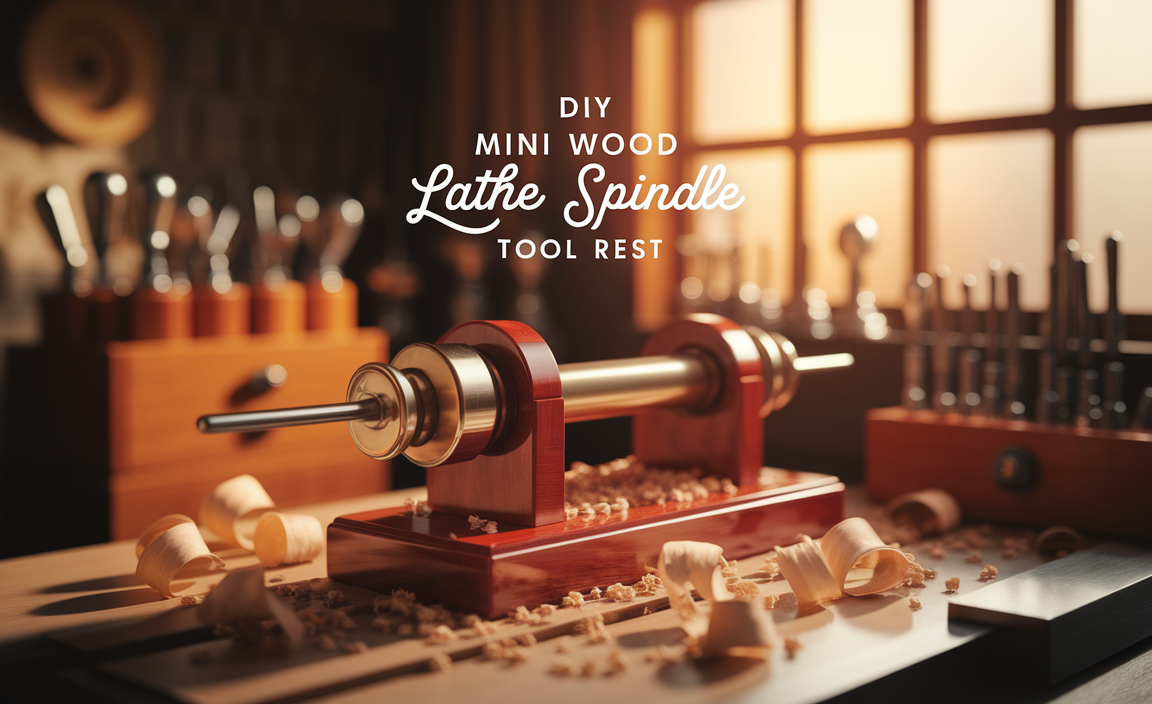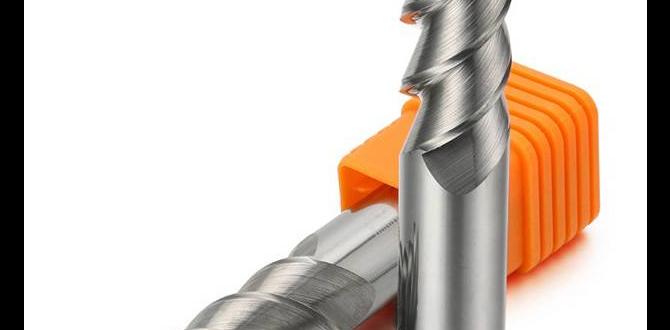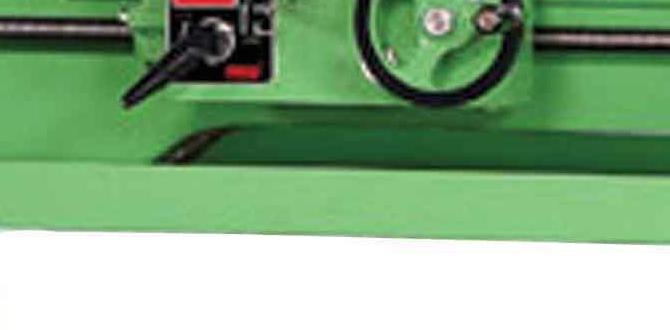Quick Summary: Choosing the right lathe cutting tools is crucial for success. This guide simplifies selecting and using essential tools like HSS, carbide, and specific types such as roughing, finishing, and threading tools, ensuring clean cuts and great results for beginners.
Welcome to Lathe Hub! If you’re just starting with a lathe, either for metal, wood, or even plastics, you’ve probably noticed there’s a whole world of cutting tools out there. It can feel a bit overwhelming, right? Don’t worry, it’s a common feeling. The good news is, once you understand the basics, choosing and using these tools becomes much simpler. Think of your lathe cutting tools as the essential brushes for your artistic creation, whether you’re shaping a table leg or a precise metal component. Getting them right means smoother operations, better finished pieces, and a more enjoyable experience.
In this guide, we’ll break down the types of cutting tools, what they’re best used for, and how to pick the perfect one for your project. We’ll cover everything from the materials they’re made from to the specific shapes you’ll encounter. Ready to turn your challenges into triumphs? Let’s dive in!
Understanding the Basics: What Are Lathe Cutting Tools?
At their core, lathe cutting tools are designed to remove material from a workpiece as it spins on the lathe. They come in various shapes and sizes, each specialized for different tasks. The key to successful lathing lies in matching the right tool to the job, the material you’re working with, and the desired outcome. Using the wrong tool can lead to poor finishes, tool breakage, or even safety hazards.
Imagine trying to spread butter with a saw, or saw wood with a butter knife. It just doesn’t work well! The same principle applies to lathe tools. Each tool has a specific geometry – angles, edge sharpness, and shape – that dictates how it interacts with the spinning material. Understanding these fundamentals will boost your confidence and your project quality significantly.
Materials Matter: High-Speed Steel (HSS) vs. Carbide
The material of your cutting tool is one of the most significant factors affecting its performance. The two most common materials you’ll encounter are High-Speed Steel (HSS) and carbide.
High-Speed Steel (HSS)
HSS is a classic choice, especially popular in woodworking and for general metal turning by beginners. It’s known for being tough and relatively easy to sharpen. HSS tools can withstand higher cutting speeds than carbon steel tools without losing their temper (hardness). However, they do have limitations compared to carbide.
- Pros:
- Easier to sharpen by hand.
- Less brittle than carbide, meaning they can tolerate minor impacts better.
- Good for a wide range of materials.
- More affordable initially.
- Cons:
- Can wear out faster at higher speeds.
- May require more frequent resharpening, especially on harder materials.
- Can overheat if not used with proper coolant or cutting fluid in metalworking.
Carbide Inserts
Carbide, often in the form of inserts that are clamped onto a tool holder, is the modern workhorse for metal machining. It’s extremely hard, allowing for much higher cutting speeds and longer tool life between sharpenings. However, carbide is also more brittle.
- Pros:
- Excellent hardness allows for very high cutting speeds and feed rates.
- Longer tool life, especially in production environments.
- Consistent cutting edge.
- Inserts are easily replaceable, reducing downtime.
- Cons:
- More brittle; can chip or break if dropped or subjected to shock.
- Requires a specific tool holder system.
- Sharpening is typically done by specialized grinding services, not easily by hand.
- Higher initial cost for tool holders.
For beginners, HSS is often recommended for its forgiving nature and ease of maintenance. Many hobbyists start with HSS and move to carbide as their needs become more demanding. For metalworking, carbide inserts are almost standard for efficiency and performance.
Essential Lathe Tool Types: Your Go-To Arsenal
Beyond the material, the shape and purpose of the cutting edge define a tool. Here are some of the most essential types of cutting tools for lathes that you’ll find yourself using regularly:
1. Roughing Tools
These tools are designed for heavy material removal. They have a robust, often rounded, cutting edge that can handle taking substantial cuts to quickly reduce the workpiece diameter or remove excess material. They aren’t concerned with a fine finish, but rather efficiency in shaping the basic form of your part.
2. Finishing Tools
As the name suggests, finishing tools are used to create a smooth, precise surface. They usually have a finer, sharper cutting edge and are designed to take light cuts. These tools are crucial for achieving the desired final dimensions and polish on your workpiece. They can have various nose shapes, like round or diamond, for different effects.
3. Parting Tools (or Cut-off Tools)
These tools are specifically made for cutting a workpiece completely off the stock material or for cutting narrow grooves. They have a thin, deep blade designed to plunge directly into the material with minimal side contact. It’s important to use these tools correctly; a bent or broken parting tool is a common issue for beginners.
4. Threading Tools
Creating threads on a lathe is a specialized operation. Threading tools have a cutting edge shaped to match the specific profile of the screw thread you want to create (e.g., V-shaped for standard metric or UNC/UNF threads). They are used in a sequence of lighter cuts to form the threads gradually.
5. Grooving Tools
Similar to parting tools but designed for making internal or external grooves of specific widths and depths that remain part of the workpiece. They come in various widths and shapes for different grooving applications.
6. Boring Bars
Boring bars are used to enlarge existing holes or create new ones on the inside of a workpiece. They are essentially single-point cutting tools mounted on a rigid bar. They come in different lengths and diameters to reach into the workpiece.
Understanding Tool Geometry: Angles and Edges
The shape of the cutting edge, often referred to as tool geometry, is critical. These angles affect how the tool cuts, the quality of the surface finish, and the tool’s longevity. While it might sound complex, a basic understanding helps immensely.
- Rake Angles: This refers to the angle of the tool’s cutting face relative to the workpiece.
- Back Rake: The angle on the top surface of the tool. Positive back rake helps curl chips away and reduces cutting pressure, good for softer materials. Negative back rake is used for harder materials and provides more support to the cutting edge.
- Side Rake: The angle on the side of the tool that slopes away from the cutting edge. Similar to back rake, positive side rake aids in chip curling and reduces force.
- Clearance Angles (Relief Angles): These are the angles on the sides and front of the tool that keep the cutting edge from rubbing against the workpiece.
- End Clearance: The angle on the “front” of the tool.
- Side Clearance: The angle on the “side” of the tool.
- Cutting Edge Radius/Nose Radius: The curvature at the tip of the tool. A larger radius can lead to a better surface finish but requires more cutting force and can cause chatter if too large for the feed rate or material. A smaller radius or sharp point is better for detail work but can be more prone to chipping.
For beginners, most pre-ground HSS tools will have a suitable geometry for general-purpose work. When you start grinding your own tools or buying specialized inserts, paying attention to these angles becomes more important.
Lathe Tool Holding and Setup
Holding your cutting tool correctly is as important as the tool itself. The tool must be held securely in the tool post and positioned at the correct height and angle relative to the workpiece.
Tool Post Types
Tool posts vary. The simplest is the T-slot tool post found on many beginner lathes, where tools are held by clamps or T-nuts. More advanced are the quick-change tool posts, which allow for rapid tool changes and precise height adjustments without repositioning the tool holder each time.
- T-Slot Tool Post: Simple, robust, but slower to adjust.
- Quick-Change Tool Post: Offers speed and precision, highly recommended if your budget allows. Brands like Aloris are well-known but costly; many import versions offer good value.
Tool Height and Alignment
The cutting tip of your tool should generally be set level with the center of the workpiece. Setting the tool too high or too low can lead to poor cutting action, tool damage, and undesirable finishes. Many tool holders have adjustable shims to fine-tune height, or you can use a knurled adjustment on some tool posts.
Tool Angles in the Tool Post
When mounted, the tool should generally be perpendicular to the workpiece axis for facing operations and parallel for turning operations. Slight adjustments can be made for specific cuts, but starting with a square setup is key.
Choosing the Right Tool for Your Material and Task
Now, let’s put it all together. How do you pick the correct “cutting tool for a lathe” for your specific need?
For Woodworking Lathes:
Woodturning tools are typically made of high-carbon steel or HSS. They have distinct shapes for carving, hollowing, and shaping wood. Common tools include:
- Gouges: Used for roughing, shaping, and hollowing curves. Be sure to maintain a sharp edge, as dull tools tear wood.
- Scrapers: Used for smoothing curves and internal surfaces.
- Skew Chisels: Versatile tools for fine shaving, parting, and creating flat surfaces.
- Parting Tools: For cutting off completed pieces.
Sharpening is a critical part of woodworking with lathes. Tools can be sharpened on grinding wheels, often with jigs to maintain the correct bevel angles. For more on sharpening, check out resources from organizations like the American Association of Woodturners (AAW).
For Metal Lathes:
Metal turning requires robust tools capable of handling higher forces and generating heat. HSS is common for hobbyists, while carbide inserts are preferred for production or tougher metals.
General Turning (Reducing Diameter):
Right-Hand Turning Tool: Used for general turning from right to left along the workpiece. For HSS, a ground tool is common. For carbide, you’ll use a tool holder with a positive or negative rake insert, depending on the material and operation. A tool with a decent nose radius (e.g., 0.030″ to 0.060″ or 0.8mm to 1.5mm) works well for many general-purpose turning tasks.
Facing (Creating a Flat End):
Facing Tool: Can sometimes be a modified turning tool or a specialized facing tool. Often, a right-hand turning tool set at a slight negative angle can be used for facing. For precision facing, a tool with a sharp point or tiny nose radius is preferred.
Grooving and Parting:
Parting Tool: For cutting off, use a dedicated parting tool. Ensure it’s narrow enough for your needs and that the workpiece is well-supported in case of chatter. For metal, a tool width of 0.060″ (1.5mm) to 0.125″ (3mm) is common for many applications. Always feed straight in.
Grooving Tool: For making grooves, use specific grooving inserts or ground tools matching the desired width. These are often held in a specialized tool holder.
Threading:
Threading Tool: Requires a specific threading insert or a ground HSS tool that matches your thread form (e.g., 60-degree for ISO, UNC, UNF). Specialized threading tool holders are often used for precision and consistent depth of cut.
Regarding metal lathe tools, the U.S. Department of Labor’s Occupational Safety and Health Administration (OSHA) provides standards for machine guarding, which indirectly relate to safe tool usage by ensuring no loose parts or unexpected tool failures can occur.
A Simple Table of Common Lathe Tools
Here’s a quick reference table to help you identify common tools and their uses:
| Tool Name | Primary Use | Material Type | Key Features | Beginner Friendliness |
|---|---|---|---|---|
| HSS Roughing Tool | Heavy material removal, shaping basic forms | High-Speed Steel | Robust, often rounded edge, takes deep cuts | High – easy to resharpen |
| HSS Finishing Tool | Achieving smooth surfaces, precise sizing | High-Speed Steel | Sharp edge, finer nose radius, takes light cuts | High – easy to resharpen |
| Carbide Insert Turning Tool | General turning, high-speed metal removal | Carbide Inserts (in holder) | Interchangeable inserts, various geometries and coatings | Medium – requires tool holder and insert selection |
| Carbide Insert Facing Tool | Creating flat surfaces on metal | Carbide Inserts (in holder) | Specific geometry for facing, sharp cutting edge | Medium – specific application |
| Parting Tool | Cutting off workpieces, cutting narrow grooves | HSS or Carbide | Thin, deep blade, must be rigid | Medium – prone to chatter/breakage if misused |
| Boring Bar | Enlarging or creating internal holes | HSS or Carbide Inserts | Long, slender tool held in a bar | Medium – requires careful setup |
| Threading Tool | Cutting screw threads | HSS or Carbide Inserts | Precise thread-form cutting edge | Low – requires specific setup and technique |
Safety First: Always Prioritize Safe Practices
Lathes are powerful machines, and cutting tools are sharp. Safety should never be an afterthought. Always follow these basic rules:
- Wear Safety Glasses: Always, without exception. Flying chips or tool fragments can cause severe eye injury.
- Secure Your Workpiece: Ensure your workpiece is properly chucked or held. A work piece coming loose can be extremely dangerous.
- Secure Your Tool: Make sure your cutting tool is firmly seated in the tool post and clamped securely.
- Keep Hands Away: Never touch a spinning workpiece or cutting tool.
- Remove Wrenches: Always remove chuck keys and any tool-setting wrenches before starting the lathe.
- Use Appropriate Speeds and Feeds: Start slow, especially when learning. Consult charts or your machine’s manual for recommended speeds for different materials and operations.
- Use Cutting Fluid (for Metal): For metalworking, cutting fluid or oil is essential for cooling the tool and workpiece, lubricating the cut, and clearing chips.
- Keep Your Machine Clean: Remove chips frequently with a brush, not your hands.
- Know Your Tools: Understand the limitations and capabilities of each tool you use.
Many manufacturers and educational institutions offer detailed safety guidelines. For instance, the Association for Manufacturing Technology (AMT) often publishes best practices for machining safety.
Sharpening and Maintaining Your Tools
For HSS tools, knowing how to sharpen them is a valuable skill. A properly sharpened tool cuts cleanly, efficiently, and safely. Dull tools require more force, which can lead to tear-out in wood, chatter in metal, and increased risk of tool breakage.
Sharpening HSS Tools
You’ll typically need a grinding setup (bench grinder with appropriate wheels, or specialized sharpening systems) and honing stones or diamond files.
- Set Up: Ensure your grinding wheel is clean and dressed. Determine the correct bevel angle for your tool (angles vary depending on the tool’s purpose).
- Grind: Carefully bring the tool’s cutting edge to the grinding wheel, maintaining the correct angle. Move the tool back and forth to avoid creating a single hot spot. Use water or coolant to keep the tool from overheating, which can draw its temper.
- Hone: After grinding, the edge will have a “burr” and microscopic unevenness. Use a fine-grit sharpening stone, diamond file, or honing strop to remove the burr and create a polished, razor-sharp edge.
Carbide inserts are usually replaced rather than sharpened by the user. When an insert becomes dull, you simply remove the old one and install a new one. This is one of their major advantages in a production setting.




